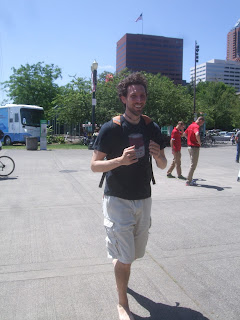Everybody bounces up and down when they run. If you’re human then it’s going to happen. As Sanatan told me in Week 3, the only way to avoid bouncing at all to walk like Groucho Marx (not recommended), but ideally bouncing should be kept to a minimum. Once you’re aware of how much you’re moving up and down, it isn’t hard to make natural adjustments to reduce it. The trick is to become aware of the movement and gauge just how much it’s happening. That’s where the backpacks come in.
When you run with a backpack, you can tell very easily how much you’re bouncing just by feeling how the straps are bouncing on your shoulders. Simple adjustments to your movement will lower the bounciness of those straps, although turning it into a habit seems to be the real challenge. Of course, Sanatan had a drill for that.
Backpack Drill!
He had us split into several groups and stand on opposite sides of the Salmon Street fountain with at least one backpack in every group. It took some choreography, but we managed to work out a system in which you ran with a backpack on your shoulders from one group to the next, then passed your backpack to the next person and ran back without it. By the time you returned, a backpack would come back to you and you would put it on and start over. So, run with a backpack, run without a backpack, run with a backpack, run without a backpack, etc. The result was a brief period to gauge and correct our bounciness with a backpack followed by a period of putting it into practice without anything on your shoulders.
In my own experience, practicing the Switchie drill (peeling your foot off the ground smoothly) and the Soft Top drill (landing softly) made a big difference in keeping bouncing to a minimum.
Calf Raise 100 Demonstration
We ended this session with a drill of calf raises. This is a common exercise: stand with the ball of your foot on the edge of a ledge or step and raise yourself up and down, using one foot at a time. Keep knees slightly bent, just like in running. We did 100 of these and tried to keep it at a running pace, so about 100 per minute. I asked if this was a recommended warm-up exercise, but Sanatan said it was better to do after a run to help keep calves loose—definitely one of my concerns. Here's his explanation of why we do this exercise:
"Our shoe-weakened calves are often the most stressed muscle group early on in transition, especially as many of us overdo the forefoot strike as we try to avoid the dreaded heel strike. This quick drill is designed to prepare the calves for their extra work, especially for those earlier in their transition, AS WELL AS increase the natural rebound efficiency of even the most experienced ’springs’. This drill is to be done daily until easy, unless there is pain or significant soreness."And here's the video demonstration with more details:
Next week's topic: Should I be running on my toes? Foot-strike demystified!
Minimalist Mondays is a free injury-free running workshop that meets weekly in downtown Portland, Oregon. It is taught by Dr. Sanatan Golden and Dr. Ray McClanahan. Everyone is welcome! For more details, including recaps of past lessons, visit the Minimalist Mondays website.




0 comments:
Post a Comment